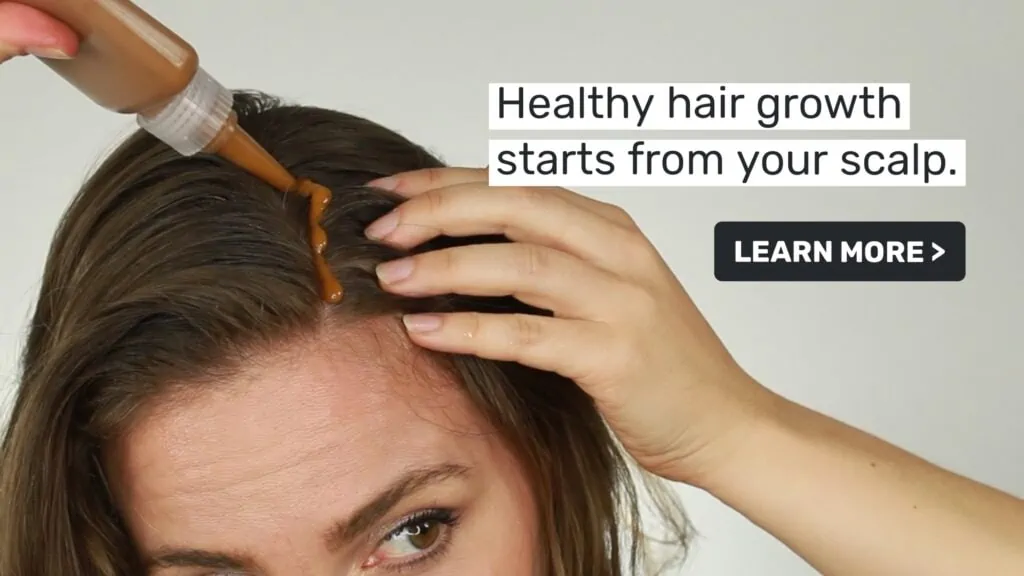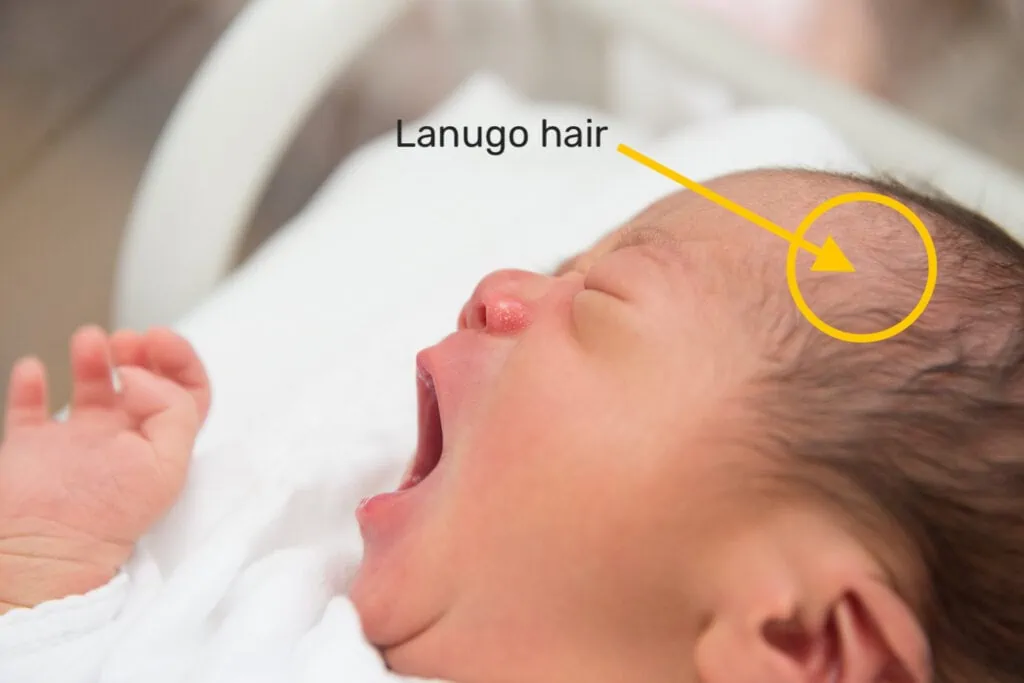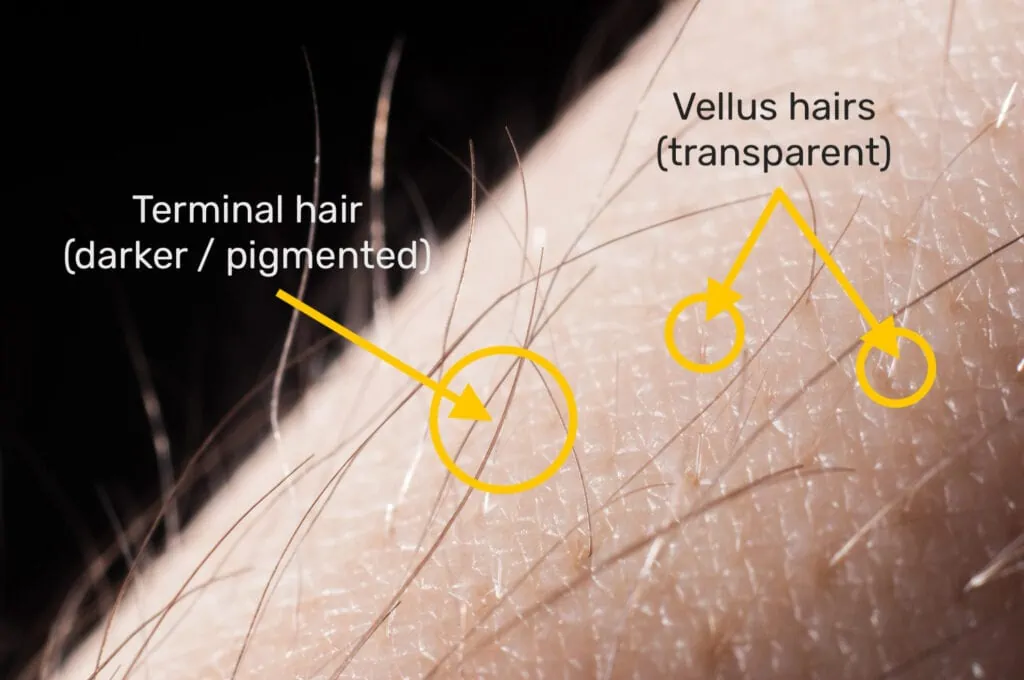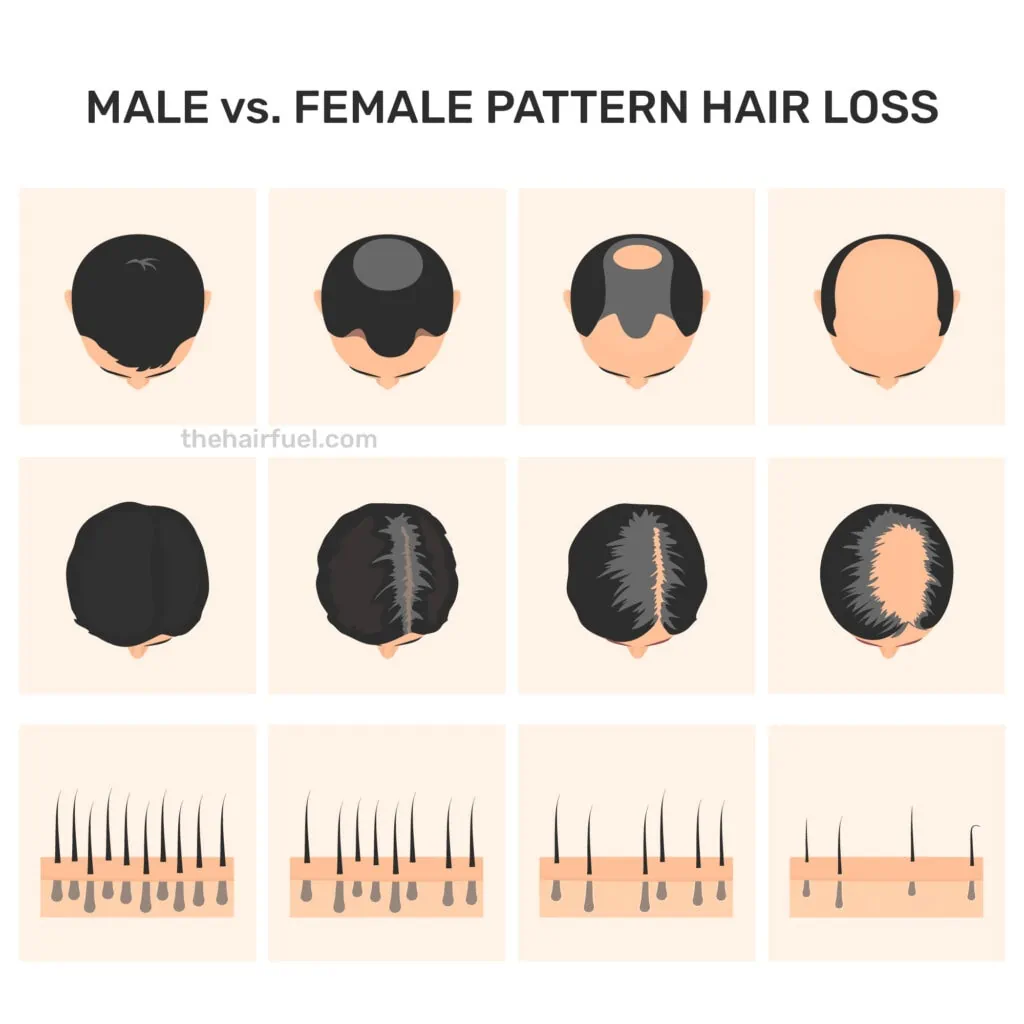If you are not growing visible hair, it does not mean that you have dead hair follicles. In order to destroy a hair follicle, you really need to damage the bulb or the root of the hair follicle where the blood supplies it with oxygen. This takes a significantly longer time than people tend to believe when they don’t see visible hair growing on their scalp. The stem cells responsible for hair follicle regeneration need to be absent too.
This should be a hopeful message, since unless you have had a deep wound or dead hair follicles during a long-term balding process – chances are your follicles are not dead.
**This post is mostly for hair nerds like us, who want to understand the biology behind hair growth, hair loss, and hair follicles in general. As a hair-growing blog, we couldn’t remain ignorant if a hair follicle dies, and even IF it does appear dead, what happens next and IF it can be revived? Originally written in May 2019 and updated in November 2022.**
Each follicle is a complex organ which, before exhibiting signs of a dead hair follicle from “natural causes” – such as hair thinning due to androgenic balding, goes through stages: vellus > terminal hair > vellus.

Understanding hair follicle lifecycle
In animals and from the evolution perspective, the hair growth cycle exists to renew the protective covering of body hair, while also enabling seasonal changes in coat quality and color when it comes to animals. The length of phases within this cycle determines the length of the hair and its replacement rate (think of hair molting/shedding).
In humans, such a cycle determines characteristics of hair across different body areas and also helps to explain what dead hair follicles look like.
The cyclical nature of hair growth has a distinct purpose, but hair industry is very keen to understand the transitions between the phases of the cycle in order to manipulate hair growth. Much of this area is still unknown however much advancement has been made.
Instead of diving into the stages of anagen (growth), catagen (detachment) and telogen (falling out), we’re looking at the larger cycles that span the entire lifetime of a hair follicle as an organ, rather than one standalone hair. These stages are:
- (1) lanugo
- (2) vellus
- (3) terminal.

1. Lanugo hair
When we are born, some of us retain lanugo hair – a downy-like hair usually found on the body of a fetus or newborn baby. It is the first hair to be produced by the fetal hair follicles, and it usually appears on the fetus at about 5 months of gestation. Lanugo is very fine, soft, and usually unpigmented. It is normally shed before birth, around seven or eight months of gestation, but is sometimes present at birth. It disappears on its own within a few weeks.

2. Vellus hair
Lanugo is replaced by hair covering the same surfaces, which is called vellus hair. This hair is thinner and more difficult to see. This is commonly the “peach fuzz” or just hair on the rest of human body, other than head, eyelashes and eyebrows during childhood.
3. Terminal hair
As we transition into adulthood, some vellus hairs change into terminal hairs which form in specific areas and is hormone-dependent. Such conversion is commonly present in armpit, pubic, chest areas in both genders which react to hormonal changes in our bodies. This can happen due to puberty or menopause – or taking a hormonal medication, such as birth control pill or thyroid medication.
Terminal hair has a medulla – a central “spine” of the hair, which is typically non-existent in finer, vellus hair. The medulla is a portion of the hair’s core that strengthens it, allowing it to grow longer.

Hair follicle miniaturization before its death
During the hair thinning and balding process, terminal hair progresses back into vellus hair as part of the hair follicle miniaturization stage. It can remain in the vellus stage, continuing to grow a peach fuzz, without the actual follicle itself dying.
However for the hair follicle to die completely it takes a long time. Research conducted around stem cells in the hair growing areas points to the fact that even after the hair follicle does effectively die (i.e. it does not produce any type of hair, including vellus) – some stem cells can create new hair follicles.
How to tell if hair follicles are dead? For now, it is important to remember that just because there is no visible hair – it doesn’t mean that you have dead hair follicles. Oftentimes even visibly completely bald scalp has some peach fuzz, which points to the fact that the follicles aren’t dead, but they are in a different stage – of follicle minituarisation – as a vellus hair.
What does a dead hair follicle look like
Dead hair follicle is the one that no longer can grow hair. But even when you first notice some hair thinning, your hair follicles already receive progressively less and less blood supply to them. Although it is often not the lack of blood flow that leads to baldness as there are other factors, e.g. hormones at play, but rather it is the result of it.
The lack of appropriate blood circulation worsens and accelerates hair loss, since the root no longer receives sufficient oxygen and other nutrients normally delivered by blood vessels connected to each hair via derma papilla. This lack of nutrition leads to a catch-22 process of hair miniaturisation and can ultimately lead to hair follicle dying and no longer growing hair.
Dead hair follicle re-birth
Stem cells in follicle formation
Aside from the differentiation between vellus hair and terminal hair, there is a number of stem cells present in scalp. Those stem cells need to transition to “progenitor” stage before leading to hair growth. You can think about progenitor cells not entirely devoid of purpose unlike stem cells, but rather those which already leaning towards a target cell. Interestingly, in balding men, scientists observed the same amount of stem cells in the balding areas as in the non-balding areas, though in the non-balding areas there was a greater number of activated progenitor cells. This means that even in bald scalp there may be a potential to start growing hair again, although the sooner you address your hair loss the better and quicker results would be.
Dead hair follicles in patterns of baldness
In androgenic alopecia (AGA) – commonly the reason behind male pattern baldness, is not only limited to men. AGA occurs in areas that exhibit thinning of the hair first: specifically frontal and vertex (crown) areas, in women the pattern is diffused across the entire scalp. These are the areas with most androgen-receptors – which react most actively to dehydrotestosterone (DHT) attacking them, which ultimately leads to hair follicle miniaturisation and visible baldness.

Many treatments for baldness attempt to convert vellus hair back to terminal hair by preventing DHT from attacking the hair root. Because it is much easier to reverse the hair thinning, while hair follicle produces at least some type of hair, hair loss treatments are more efficient in delivering visible results faster, before the hair enters the vellus stage.
While this topic is common amongst balding males, there are plenty of instances of androgenic female pattern hair loss, especially linked to menopause or polycystic ovary syndrome, due to changes in hormonal balance and an increase in production of androgens in females. The process where hair follicle goes back to vellus hair applies to all genders.
Stimulate dead hair follicles for hair regrowth
Firstly, let us be very clear – acting early is key. The good news is that if you have ANY hair – even if it just looks like fluff – it means that your hair follicles are still alive and able to grow hair. They might need support: through the right nutrients, hormone regulation and stimulation of scalp blood flow – the bottom line is that there is something you can do about it.

While balanced, nutrient-rich & anti-inflammatory diet, right supplements and exercise are paramount in achieving hair growth – stimulation of blood flow in scalp is key. Regrowing hair isn’t as easy as popping pills and occasionally spraying minoxidil on your hair roots, blood flow stimulation of scalp is one of the most promising sustainable solutions for improved hair growth, re-growth and reduction of hair loss.
Some techniques for scalp blood flow stimulation include scalp massages, derma-rolling (also known as micro needling). Some scalp treatments promote blood flow to hair follicles directly, with a dual action as they also deliver its own nutrients to them.
Conclusion
Hair thinning and hair loss treatments have much greater success when performed in the early stages of hair loss – when you just start noticing hair thinning. It becomes much harder to revive dead hair follicles and stimulate the formation of correct hair progenitor cells in the scalp – once your hair is already in the vellus stage.
Who we are:
The Hair Fuel is an all-natural hair growth mask created by Laura Sagen, who lost a third of her hair after a terrible visit to a hairdresser while suffering from a life-long condition of PCOS associated with androgenic hair thinning. She developed the formulation rooted in the science of scalp blood flow, which has become The Hair Fuel growth mask. Since then, her company has helped thousands of people like you to start growing healthy hair.
We work closely with our lab and manufacturers to ensure the highest quality product. But a product alone is never enough – so we hold your hand throughout your own, unique hair growth journey. Our flagship product, The Hair Fuel mask coupled with tailored advice, digital tools, and online support is there to help you grow the best hair you can. It’s a big claim – but we’re unafraid to make it. Check out our starter bundles >>
Sources:
Bald scalp in men with androgenetic alopecia retains hair follicle stem cells but lacks CD200-rich and CD34-positive hair follicle progenitor cells (1)
The biology of hair diversity, (2)
Multivariate analysis of prognostic factors in patients with rapidly progressive alopecia areata (3)
Subcutaneous blood flow in early male pattern baldness (4)
FAQ
-
1. What stimulates hair follicle growth?
Blood flow to scalp stimulates proliferation of keratinocytes in the hair follicle, thus stimulating hair growth. Various techniques, such as scalp massage, dermarolling, certain topical products can temporarily improve blood supply to scalp.
-
2. How long does a hair follicles take to grow?
Average human hair growth rate is approximately ½ inch or 1 cm a month. However hair follicles aren’t always in the growth stage: anagen – the growth stage takes 2-7 years in which human hair follicle grows hair. After that, a follicle enters catagen – which takes 10-14 days where hair detaches itself from the blood supply at the bottom of the hair bulb. Following this, the follicle enters resting stage, telogen, which takes 3 months. After that it enters anagen once again.
-
3. How do you revive dead hair follicles?
You can’t revive a dead hair follicle, but frequently the hair follicle presumed dead is actually alive whilst growing translucent hair almost invisible at first glance. Such hair follicles can be supported to grow thicker hair by improving blood flow to the scalp.
-
4. Can dead hair follicles be revived?
Hair follicles that got destroyed as a result of scarification (e.g. injury or considerable damage to scalp) cannot be revived. However if a hair follicle grows even a translucent hair – it is not dead and can be revived to grow thicker, more visible hair.
-
5. How can I reopen my hair follicles naturally?
Improving blood flow to the scalp through various techniques and tools can help stimulate your hair follicles to grow thicker hair.
-
6. Can shrunken hair follicles grow back?
Yes. Stimulating hair follicles by improving blood supply to them can help increase the size of shrunken hair follicles thus improving growth, providing that the hair growth isn’t suppressed by a medication or condition that directly affects hair growth. In the latter cases, hair health needs to be carefully managed and monitored in order to help hair regrowth as you manage your health condition. Find out more about tools and techniques for hair health management here.

Hi. I’m living in Australia. There is no option for Australia to order the mix oil on your website. How can I order it? Thank you
Hey Darya! Thank you for your message! We haven’t launched in Australia yet – but we are planning to in autumn 2020. If you have friends based in the US or Europe we can ship the packages to them and they can post it to you. If you’d like to explore that option, drop us an email to customer@thehairfuel.com! xoxo
What is a mix oil that is not available Australia? I read everything ,but perhaps I missed some, I would like to know more about this oil and price
Recently I had a hair transplant in Portugal , I need some kind a natural source to feed my hair that are growing slow, I loved your information , I never read such an informative like this in thehairfuel.com
Thanks so much
Hi Maria! You can find the ingredients of the mask in the FAQ section here: https://www.thehairfuel.com/home/faq/
We currently do not ship to Australia, however we are planning to in the foreseeable future!
what about a female with baldness from a hair chemical, can she regrow her hair?
Hi Frank, Thanks for your question. You need to be a bit more specific as to what hair chemical caused the baldness… do you want to share more?
What about hair thinning from using gx grey shampoo? Will it grow back full again after the months of hair fall stops and if so how long could it take?
Hey Tony. Thanks for your question – if a product causes hair thinning from using a product… suggest to stop using the product! It can also happen that natural hair thinning coincided with the use of the shampoo, so suggest stopping the shampoo for 3-6 months and observe if hair regains its thickness. Meanwhile, supporting your scalp with some blood-flow tools, products and routines is a good idea. Blood flow plays crucial role in hair thickening and strengthening, but the effects do take time, since it relates to the diameter of the hair follicle. Depending how long your hair actually is – it may take to a few months to a year.
Dr doctor, I have been dieting since 4 years and I have hair loss since for years due to cte. Does it mean that my entire hair density will not come back due to lack of nutrition for many years ?
Hi Keyuri, I’m sorry to hear your battle with CTE… Nutrition is one of the most important things to get right when it comes to managing hair loss. Some diets are too-restrictive and don’t provide enough nutrients for the body to grow healthy hair. It helps to regularly take supplements: ensuring you get all the vitamins, zinc, magnesium and iron as the basics – those are the easiest to get in your local drugstore / pharmacy over the counter. It doesn’t sound like a fancy hair advice – but it works! Ensuring you have necessary calorie and macros (carbohydrates, proteins and fat) intake according to your age and health condition is also key! Do let us know if you want more info – you can always drop us an email to customer@thehairfuel.com x